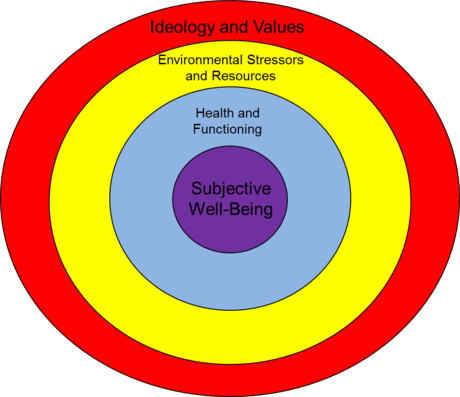Happiness
The Nested Model of Well-Being
A unified approach to understanding well-being.
Posted June 3, 2014
What are the elements that go in to the concept of well-being? An approach to well-being that attempts to clearly delineate the answer to this question was just published in the most recent issue of Review of General Psychology.
The paper, authored by myself and Drs. Kimberly Kleinman and Craig Asselin, argues that although well-being is perhaps the single most important concept in positive psychology, it remains the case that there is much ambiguity in the meaning of the term in the literature. To begin to get a sense of the potential for confusion, consider the following questions: Is well-being the opposite of pathology or are these two separable dimensions? How does the subjective, first person experience of wellness (or distress) relate to functioning in the biological, psychological and social domains? Can well-being be objectively analyzed and measured, like the amount of carbon in the atmosphere, or is well-being an inherently value-laden construct? Put differently, do we need to consider the moral dimension when considering well-being?
The paper attempts to explicitly delineate the domains that go into the concept of well-being in a way that is simultaneously: 1) clear and straightforward and 2) anchored to a theoretically sophisticated formulation of the human condition. It accomplishes this by introducing the Nested Model, which posits that there are four nested domains that make up the construct of human well-being: 1) the Subjective Domain, which is the first person, phenomenological, conscious experience of happiness (versus misery) along with the self-conscious, reflected levels of satisfaction (or dissatisfaction) with life and its various domains; 2) the Health and Functioning Domain, which can be further divided into two broad dimensions of functioning, the biological and the psychological; 3) the Environmental Domain, which can also be effectively divided into two broad domains of the material and the social environment; and 4) the Values and Ideology Domain, which refers to the morals, ethical perspective, and worldview of the evaluator.

Authentic well-being is achieved when there is the positive alignment of these domains. That is, an individual is high in well-being when they are happy and satisfied with their lives, are functioning well psychologically and biologically, have access to necessary and desired material resources and social connections to meet their needs (and the relative absence of damaging or dangerous stressors), and are engaging in life with a purpose and a direction that is deemed by the evaluator to be good and moral. The paper articulates how this model resolves many of the long standing debates in the field, integrates hedonic with eudiamonic approaches to well-being, and offers a coherent way to think about well-being in relationship to illness and pathology.
If you are interested in receiving a copy of this paper, please feel free to contact me.
----
Henriques, G., Kleinman, K., & Asselin, C. (2014) The Nested Model of well-being: A unified approach. Review of General Psychology, 18(1), 7-18. doi: 10.1037/a0036288


